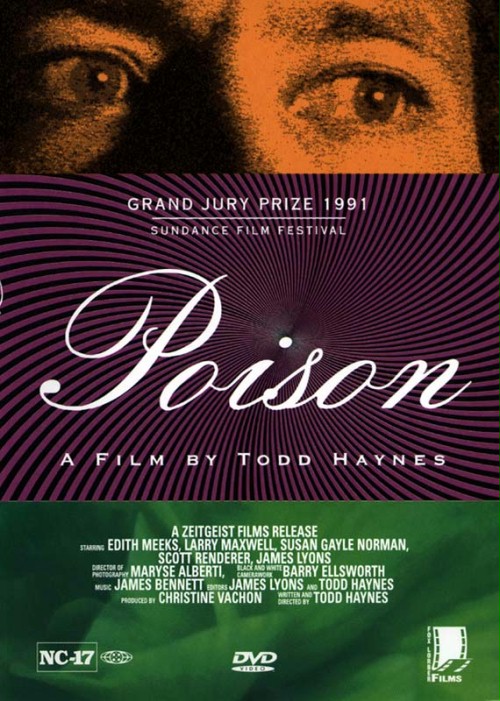Since we're not in Sundance this year, a look back at Sundance classics. Here's David on Poison...
 Glenn kicked off our Sundance retrospective with a look at Desert Hearts, a film with more than a passing resemblance to Todd Haynes' Carol; a few years down the line, and we come to Haynes’ own appearance in the Utah festival, with his feature debut Poison. Winner of the 1991 festival’s Grand Jury Prize - Dramatic, Poison is considered a vital film in the ‘New Queer Cinema’ movement of the early 1990s, as coined by B. Ruby Rich the following year. Rich’s theory involved not just the presence of LGBT characters and themes, but the queering of filmmaking form itself. Haynes had already demonstrated his inventive, radical eye in the controversial short film Superstar: The Karen Carpenter Story, and Poison, with its triptych of homonymic narratives, consolidated the director’s manipulation of nostalgia and classic cinematic forms to produce a strikingly different approach to cinema.
Glenn kicked off our Sundance retrospective with a look at Desert Hearts, a film with more than a passing resemblance to Todd Haynes' Carol; a few years down the line, and we come to Haynes’ own appearance in the Utah festival, with his feature debut Poison. Winner of the 1991 festival’s Grand Jury Prize - Dramatic, Poison is considered a vital film in the ‘New Queer Cinema’ movement of the early 1990s, as coined by B. Ruby Rich the following year. Rich’s theory involved not just the presence of LGBT characters and themes, but the queering of filmmaking form itself. Haynes had already demonstrated his inventive, radical eye in the controversial short film Superstar: The Karen Carpenter Story, and Poison, with its triptych of homonymic narratives, consolidated the director’s manipulation of nostalgia and classic cinematic forms to produce a strikingly different approach to cinema.
Each segment is presented in an individual and vivid stylistic form. 'Hero', the story of a young boy who shoots his father and literally flies away, comes as an oversaturated tabloid news documentary, containing interviews with scandalised neighbours, incisively lurid narration and tremulous recreations of the event itself. [More...]
'Horror' is shot in crisp monochrome, its extreme angles increasingly claustrophobic as it apes a '60s B-movie for the story of a doctor ingesting 'pure sex drive' and turning into a murderous leper. 'Homo' echoes the erotic bodily close-ups and prison walls of Jean Genet's Un chant d'amour for the tale of an inmate attracted to a fellow prisoner he had seen bullied in a juvenile facility in their youth.
Haynes intercuts between the three narratives with increasing frequency, never presenting neighbouring scenes as connected or necessarily reflective of each other, but using the rhythms of editing to build each to a feverish climax and using their proximity to provoke tonal shifts in the audience's perception as it races to adjust to the pace. In adopting various bold stylistic forms across his career, from the Sirkian melodrama of Far From Heaven to the glam rock swirl of Velvet Goldmine, Haynes has proven adept at subverting audience preconceptions of style and content to make pure emotional connections to the contemporary world without ever overstating the currency of their social relevancy.
Much like Haynes' later feature [safe], Poison presents narratives and characters with in such perilous physical and/or emotional states that it invites but never clarifies contemporaneous subtexts; most obviously, the repercussions of the AIDS crisis and the visibility and fear of gay men as a result. Haynes' unique unions of vivid style and emotive substance have always resisted definitive readings, and so it's more satisfying to enjoy them on an instinctive, sensual level. In Poison, that impulse creates sparks from images as diverse as Homo's picaresque flashbacks, juvenile homosocialty remembered in bright Technicolor, to Horror's claustrophobic noir sequence that makes for the scientist's libidinous first kill.
The film's prologue sets these kind of perverse pleasures immediately into the audience's minds: a young boy's hand roaming curiously, sensually over a suburban grandmother's dresser, the paraphernalia of everyday female existence made into a taboo filmed to emphasise the forbidden touch. Poison is a collection of men encountering various kinds of nominal ‘sin', and how society's judgment can twist anyone into a monster, or a brute, or even an impossibly airborne mystery.

Previously on Sundance Retro: Desert Hearts, The Brave Little Toaster, and Longtime Companion
